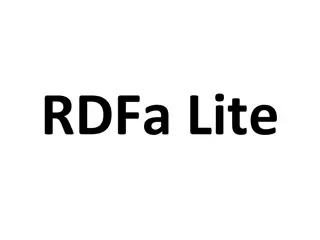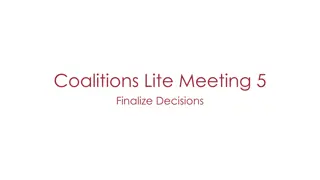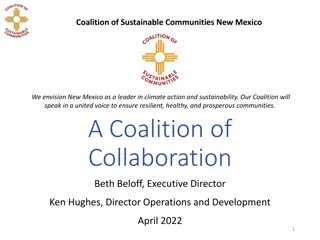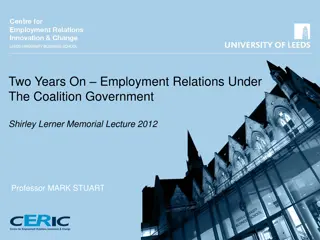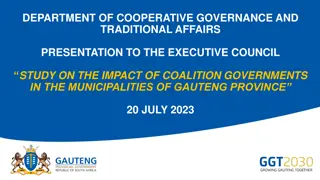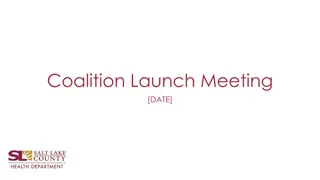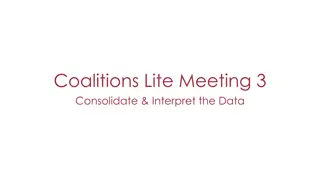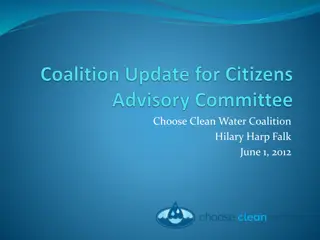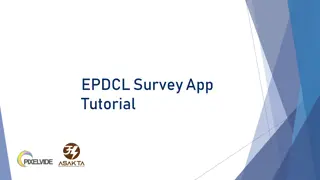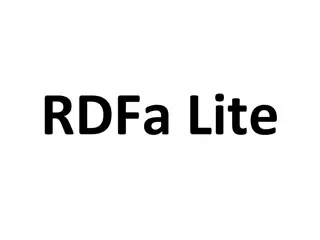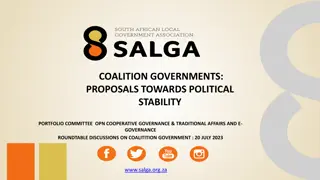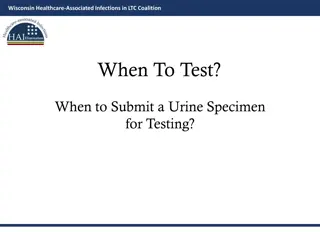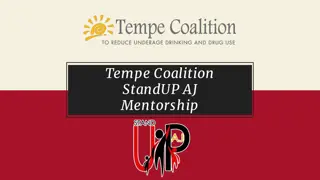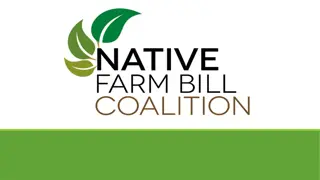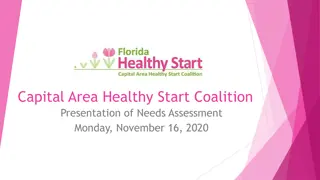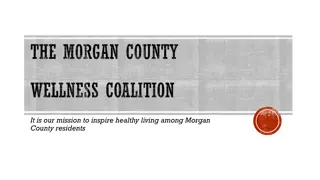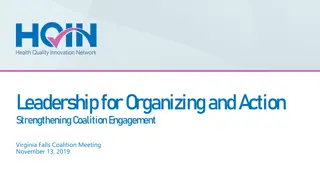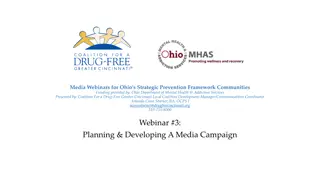Coalition Lite Meeting 1: Strategic Planning for Success
In this Coalition Lite Meeting 1, the focus is on strategizing for success through effective planning and capacity assessment. Key elements include team check-in, defining meeting objectives, assessing coalition capacity, and gaining support for strategic planning. The meeting aims to enhance the coalition's effectiveness and sustainability through clear direction and increased impact on community needs.
Download Presentation

Please find below an Image/Link to download the presentation.
The content on the website is provided AS IS for your information and personal use only. It may not be sold, licensed, or shared on other websites without obtaining consent from the author. Download presentation by click this link. If you encounter any issues during the download, it is possible that the publisher has removed the file from their server.
E N D
Presentation Transcript
Coalitions Lite Meeting 1 Plan for Coalitions Lite
Welcome, Introductions, & Overview 15 minutes
Meeting Logistics and Overview 1. Team check-in and introductions 2. Identify a notetaker and timekeeper 3. Decide on a shared document platform 4. Determine how to get feedback from stakeholders
Meeting Objectives 1.Assess the coalition s capacity to engage in Coalitions Lite strategic planning process 2.Review Coalitions Lite 3.Create a plan for conducting the Coalitions Lite process 4.Outline next steps
Assess Coalition Capacity 10 minutes
Importance of Strategic Planning for Coalitions Planning now makes for a more efficient and effective process later. Helps to identify potential barriers/prevent them. Helps to ensure our capacity for engaging in the process. Contributes to continuity and sustainability. Increase the coalition s impact in the community by focusing resources on high priority needs. Have a better understanding of the challenges your community is facing and how to best address those challenges. Provide clear direction for your activities as membership changes and grows, increasing the sustainability of the coalition and your efforts.
Coalition Capacity for Strategic Planning 1. Is this process important to our coalition s effectiveness? Why or why not? 2. Do we have enough active members to carry this work? If not, what do we need to do to increase our capacity? 3. Does everyone have a general understanding of this process?
Check-In: Thumb Vote! Does everyone support our coalition doing this work? Yes! Maybe, can we discuss? Nope!
Increasing Support and Buy-In (if needed) Meet individually with key leaders and coalition members to explain the process and why it s important. Ask them whether they can support the effort. Ask someone from the Health Department or another coalition that has conducted strategic planning to present at an upcoming coalition meeting. Other strategies to increase coalition buy-in?
Create A Plan for Conducting Coalitions Lite 45 minutes
Planning for the Coalitions Lite Process Goal: Agreement on why, when, and how the coalition will conduct Coalitions Lite To discuss: Timeline for the Coalitions Lite process Meetings Monitoring and sharing progress
Some Points to Consider for Our Timeline This process should take 4-8 months (8 months may be more realistic) Stretching the process out beyond 8 months can result in lost momentum, workgroup turnover, and needing to restart the process. Balance momentum with sticking to the process as it s laid out; don t skip steps Build in time for expected (e.g. holidays) and unexpected delays Some steps could go on indefinitely (such as data collection) Decide on a good enough stopping point Timing for step 2b Interviews / Data gathering is the hardest to predict because we may run into stumbling blocks; Step 2b is a good place to build in extra time We can always adjust the timeline as we move through the process!
Approvals and Sharing Progress What approvals do we need? Priority issues Strategies Final Strategic Plan What else? How will we update other coalition members or stakeholders on our progress? This is important for continuity, accountability, and buy-in. When, where, how, and who is responsible for updates? Consider adding a standing agenda item for updates to larger coalition meetings or sending out monthly progress emails
Monitoring & Celebrating Progress Do we need to assign someone to remind participants of their assignments and timelines? How will lack of follow-through be handled? How will we acknowledge and celebrate our progress? Celebrate individual and whole group contributions Build celebrations into timeline when certain milestones are reached Examples: gift cards, acknowledgement at larger coalition meetings, reports back to members agencies, a virtual or handwritten card, a final celebration, providing food or a special treat during a meeting, coalition swag, etc.
Meetings Will meetings be conducted in person, virtual, or both? For in person, where will meetings be held? What technology will we need? For virtual, what platform will be used? Are all members proficient with and have access to the platform? What happens when someone can t attend a meeting? Under what circumstances should a meeting be canceled or rescheduled?
Roles Who will plan and facilitate the meetings? Will we have the same people as notetakers and timekeepers every meeting or share those responsibilities? Who? Who will follow up with members after the meetings and ensure assignments and activities are on track? Who will keep an eye on timelines and other project management tasks?
What are our Expectations for Coalition Members? For attendance at meetings For responses to communications (i.e., emails) For completion of tasks For advanced notice when unable to meet or participate
Determine Resource Needs 15 minutes
What Resources Do We Need? Coalitions members with specific skills Writing, planning, design, facilitation, project management Specific experts Local data experts, service providers, report designers Funding Possible resource needs: Meeting space Materials and supplies Incentives for meeting attendance (food, drinks, etc.) Gift cards or other rewards to recognize members work Hiring someone to facilitate meetings Data collection incentives (for stakeholder interviews) Strategic Plan design and printing
What is our plan to secure the immediate resource needs? (Hint: You don t have to do it all right now!) Who will contact whom? Consider in-kind donations! Who do we know? Who can we meet? By when? What is our pitch ? How will we report back?
Identify Basic Community Strengths and Challenges 20 minutes
Brainstorm as many community strengths as you can in 5 minutes For example: caring teachers, high levels of home ownership; high graduation rates; strong sense of community; an active organization that provides helpful family programs; etc.
Brainstorm a short list of issues the coalition may want to prioritize In 1-2 minutes Shout out possible, high-level priorities that seem to be big issues in our community Capture all ideas on a flip chart Examples: Mental health, Diabetes, Substance use, Pollution, etc.
Narrow the List to 2-4 Possible Priorities (NO MORE!!) Take 3-5 minutes Narrow the list to no more than 4 Don t overthink it! If an issue feels important, it will be apparent. If multiple people see something as an issue, it s likely an issue. Write down your reasons for your final selections in the meeting notes.
Wrap-Up & Next Steps 15 minutes
Preview: Step #2 Goals Select priority issues Review basic data on the short-list of possible priorities Select 1-2 priorities to focus on right now Identify additional data to better understand the issues Quantitative data Stakeholder interviews Step 2b: Between meetings #2 and #3 Conduct interviews Collect data Prepare data for Meeting #3
Assignments Gather basic data on the short-listed possible priorities. Your local health department may be able to help. Submit the data to the coalition organizer and/or facilitator before Meeting #2. Invite any additional people to Meeting #2 who are knowledgeable about your short list of possible priorities. If not already a part of your workgroup, contact the Salt Lake County Health Department at HealthyCommunities@slco.org HealthyCommunities@slco.org for help in gathering data related to the short-listed priorities. Review the day, time, and location for Meeting #2. Notetaker: Ensure the Plan template is completed based on today s decisions. Create a shared drive file and give access to coalition members. Complete any immediate assignments from the Resources conversation. Share the plan we developed today with other stakeholders, as needed.
Check-Out Discussion: How did this meeting go? What worked well or didn t work well with the meeting? How can we run our future meetings better?


